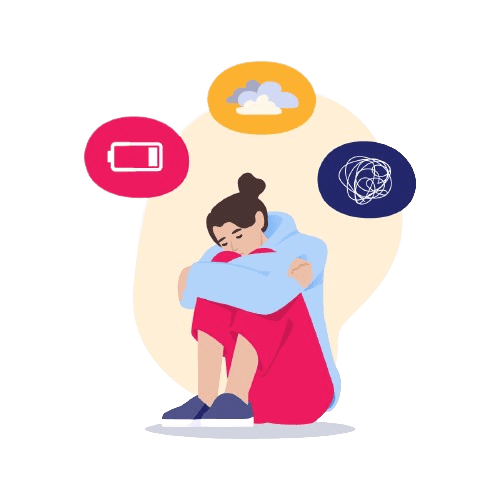Mania Assessment
3 Min Free Mania Assessment
What is Mania?
Mania is a state of abnormally elevated mood and heightened energy levels, typically associated with bipolar disorder. It is characterized by a distinct period of persistent and expansive or irritable mood, often accompanied by an increased sense of self-esteem, grandiosity, or inflated self-confidence.
During manic episodes, individuals may display a decreased need for sleep, rapid or pressured speech, racing thoughts, distractibility, and excessive involvement in pleasurable activities with a high potential for negative consequences. Mania can impair judgment, disrupt daily functioning, and lead to impulsive or reckless behaviors.
It is important to note that mania is a significant symptom of bipolar disorder, and a comprehensive evaluation by a healthcare professional is essential for accurate diagnosis and appropriate management.

Symptoms of Mania
The symptoms of depression can vary from person to person, but they often include:
- An intense, euphoric, or irritable mood
- Increased Energy and Activity
- Decreased Need for Sleep
- Rapid or Pressured Speech
- Racing Thoughts
- An inflated sense of self-esteem
- Increased Talkativeness
- Finding it difficult to concentrate
- Engaging in impulsive behaviors
- Decreased Judgment
- Increased Goal-Directed Activity
- Pursuing pleasurable activities excessively

Who Can Benefit From This Mania Assessment?
The Mania assessment can benefit individuals who suspect they may be experiencing symptoms of mania or have concerns about their mood and energy levels. It is valuable for those who want to evaluate the presence and severity of manic symptoms and assess their impact on daily functioning.
The assessment can also be helpful for friends, family members, or caregivers who want to understand the potential symptoms and challenges associated with mania. By completing the Mania assessment, individuals can gain insights into their experiences, assess the impact of symptoms, and make informed decisions about seeking professional evaluation and support.
It serves as a starting point for discussions with healthcare professionals or mental health specialists for further evaluation, diagnosis, and appropriate treatment options.
Types of Mania Assessment
Clinical Interviews
Structured or semi-structured interviews conducted by mental health professionals to gather information about the individual’s symptoms, medical history, and functional impairments related to mania. These interviews often follow established diagnostic criteria, such as those outlined in the DSM-5.
Mood Assessment Scales
Various self-report measures, such as the Young Mania Rating Scale (YMRS) or the Altman Self-Rating Mania Scale (ASRM), are used to assess the severity of manic symptoms. These scales provide individuals with the opportunity to rate their mood, energy levels, and other symptoms associated with mania.
Observation and Behavioral Assessments
Direct observation of the individual’s behavior, including their level of activity, speech patterns, and overall demeanor. Behavioral assessments may involve structured tasks or activities to evaluate impulsivity, distractibility, or goal-directed behavior.
Sleep and Activity Monitoring
Objective measures, such as actigraphy or sleep diaries, can provide information about the individual’s sleep patterns, sleep disturbances, and level of activity. Disruptions in sleep-wake cycles can be indicative of manic episodes.
Cognitive Functioning Assessment
Assessing cognitive abilities, including attention, memory, and executive functioning, can help identify any impairments or difficulties associated with mania. Psychological tests or neuropsychological assessments may be utilized.
Medical & Physical Assessment
Evaluating the individual’s physical health, conducting laboratory tests, and ruling out any medical conditions that may be contributing to or mimicking manic symptoms. This assessment helps ensure a comprehensive evaluation.
Treating Mania Issues
The treatment of mania typically involves a combination of medication, psychotherapy, and lifestyle adjustments. Here are common strategies used in the treatment of mania:
- Medication: Mood stabilizers, such as lithium, anticonvulsants (e.g., valproate, carbamazepine), or atypical antipsychotics, are commonly prescribed to manage symptoms of mania and stabilize mood.
- Psychoeducation: Learning about mania, its symptoms, triggers, and treatment options through psychoeducation can help individuals and their loved ones understand the condition better and improve adherence to treatment plans.
- Cognitive-Behavioral Therapy (CBT): CBT can help individuals identify and challenge distorted thoughts and beliefs associated with mania, develop coping strategies, and improve self-management skills.
- Family-Focused Therapy (FFT): Involving family members in therapy can help improve communication, provide support, and enhance family dynamics.
- Supportive Interventions: Engaging in support groups or peer support networks can provide a sense of community, validation, and opportunities for shared experiences and coping strategies.
- Lifestyle Adjustments: Establishing a stable daily routine, maintaining a regular sleep schedule, engaging in stress management techniques (e.g., relaxation exercises, mindfulness), and minimizing alcohol or substance use can help manage symptoms and promote stability.
- Regular Monitoring: Regular check-ins with healthcare professionals are essential to monitor medication effectiveness, manage side effects, and ensure ongoing support and guidance.
It is crucial for individuals with mania to work closely with healthcare professionals, such as psychiatrists or mental health specialists, to develop an individualized treatment plan. Treatment approaches may vary based on the individual’s unique needs, symptom severity, and response to interventions. With proper treatment and support, individuals with mania can experience symptom reduction, improved mood stability, and enhanced quality of life.

